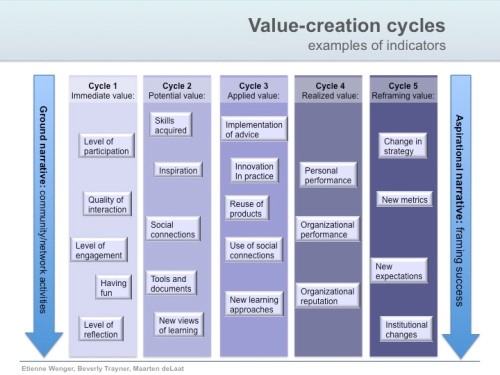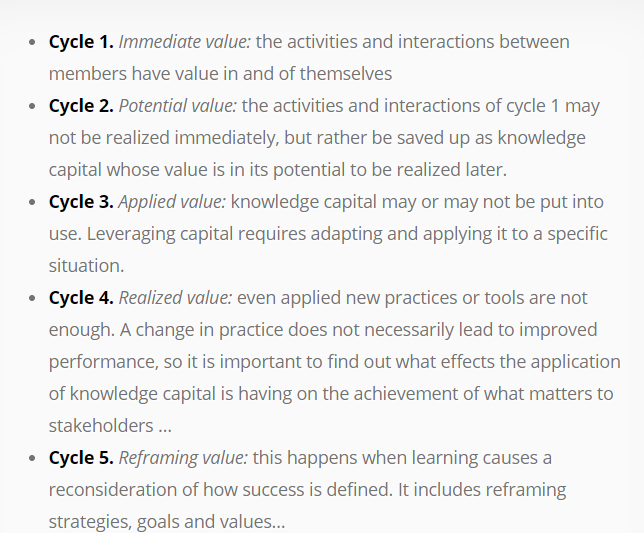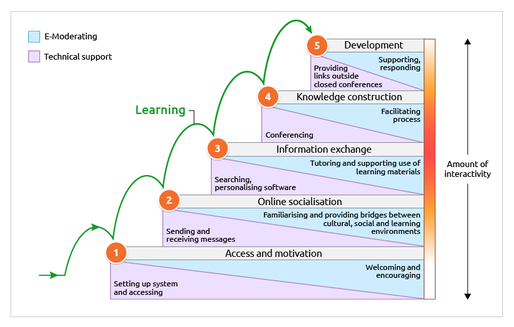Over the past decades, informatica and communication technology (ICT) became more and more intertwined in our daily lives. ICT transformed the way people work, communicate and …the way we learn. My profession as instructional designer wouldn’t exist without ICT. Online technology has influenced the way we share information, the way we generate knowledge and how innovation takes place in networks (Tsiotakis & Jimoyiannis, 2016).
But what is a network? And what is a community? In everyday speech, these two terms are used interchangeably. But the literature does show a difference.
A network is defined as ‘the set of relationships, personal interactions, and connections among participants, viewed as a set of nodes and links, with its affordances form information flows and helpful linkages. People in a network have personal reasons to connect’ (Wenger, Trayner & de Laat, 2011).
A community is the development of a shared identity around a topic or set of challenges that represents a collective intention, to steward a domain of knowledge and to sustain learning about it (Wenger et al, 2011).
A community is a network in the sense they involve connections among members. But not all networks are communities. If we look at the characteristics, we see the following differences, shown in table 1.

Table 1 Differences between network and community (Macià & Garcia, 2016, Wenger et al, 2016).
In our PBL group we discussed these differences. In this video Network is the learning George Siemens explains that ‘network is the learning’. But to what extent do you learn in a network? A network is focused on the individual learning process while a community focused on collective, collaborative learning. I believe that learning is a social process in which one gains knowledge through dialogue and discussion with others (social constructivism). Personally I think you learn more by collaboration than by networking. Collaboration is what you do in a community. The learning efficiency of a community is therefore, I think, higher than that of a network. A community has a higher yield in the sense of value creation.
Value creation
It is difficult to measure the benefits of informal learning as in an online community. It is a question that has occupied me in the past period as an Instructional Designer. While reading literature, I came across the value creation framework of Wenger et al. (2011). This framework is shown in figure 1.

Figure 1 – Value creation framework (Wenger et al, 2011)
The first four cycles in this framework are an adaptation of the four-level model of Kirkpatrick, used for evaluation to reveal the benefits of training and education. The fifth cycle is an addition made for evaluation the revenues of communities.

Figure 2 – Value creation cycles
I ask myself the question ‘what are the benefits of my participation in ONL192? What it brought me so far:
- New contacts have been made;
- Access to valuable new resources;
- New ideas for learning activities and methodologies (tweet-chat, Fish model);
- Deepening knowledge (and skills) of some educational design approaches (problem based learning, community learning).
So far, I’ve come to cycle three (figure 2). I think that cycle four and five take more time. Realized and framing value are changes that need to get more deeply rooted.
Five stages model
During topic three I read about the five stages model for online learning, shown in figure 3. I think this model have similar levels as the value creation framework.

Figure 3 – Five stage model
Learning takes place from around stage three, four by the growth of interactivity. Through the access to valuable resources, during conversations and discussions in online synchronous sessions knowledge construction takes place. Eventually, this will contribute to the development as a PBL group and also to your own development.
Integrating Value creation framework and Five stages model
As a instructional designer I’m interested in learning models. I look at the advantages the models can offer during design, development and/or evaluation phase. The two models I described briefly above gave me an insight into the development we went through as a PBL group in ONL192.

Table 2 Equation Value creation framework & Five stage model
A prerequisite for development is the motivation that must be present in the learner’s mind. In the “Five stage model’ this aspect is represented (table 2). Cycle 1 ‘Immediate value’ of the value creation framework is comparable to stage 2 ‘online socialisation’ in the five stage model. Cycle 2 ‘Potential value is covered by stage 3 ‘Information exchange’. Cycle 3 ‘applied value’ is located on the border of stage 3 and 4 of the five stage model. Cycle 4 ‘realized value’ also corresponds to stage 4 of the Five stage model. Finally, I think cycle 5 ‘reframing value’ goes one step beyond level 5 ‘Development’.
As Table 2 shows, I think there is overlap between the stages in both models. A strong point of model ‘Value creation framework’ is that it goes beyond just the development and the behavior. It has impact on your beliefs and identity. That goes beyond development.
Collaboration vs. cooperation
The condition for both models is group members working together. And that brings me to the last point in this blog. We had a discussion in our group about the difference between collaboration and cooperation.
Cooperation can be completed by dividing the labor between the participants to solve the assigned portion of the problem individually (Hut, 2017). Collaboration is about achieving the same goal where the problem cannot be solved by splitting the assignment in parts; it’s a collective activity.
Collaboration is like an orchestra in which the same script is followed by every musician and everyone will play his own role to get a sweet and melodious tune instead of his own sake (Hut, 2017).
And that’s what ONL192 is about. To achieve cycle 5 of the Value creation model or stage 5 of the Five stage model we must collaborate! Learning is a social, but also an informal process in the light of community learning.
Informal learning should be more valued, also in the context of school learning!
Resources:
- Hut, M. (2017). Difference between Collaboration and Cooperation. Viewed op 24 November 2019 by com
- Macià, M., & Garcia, I. (2016). Informal online communities and networks as a source of teacher professional development: a review. Teacher and Teacher Education
- Tsiotakis, P. & Jimoyiannis, A. (2016). Critical factors towards analysing teachers’ presence ub online learning communities. Internet and Higher Education.
- Wenger, E., Trayner, B., & de Laat, M. (2011). Promoting and assessing value creation in communities and networks: A conceptual framework. Rapport 18, Ruud de Moor Centrum, Open University of the Netherlands.